Project 2: Artist Platforms, Promotion and Documentation
Consider bodies of work that your project aspires towards and look specifically at how these have been shown and presented. Make notes about strategies you wish to borrow or use in relation to your identified reference points.
Select images of 2-3 example projects and upload these to your learning log with contextual information and your reflections.
Does the making or resolving of your work itself need to adapt in response to its intended space? Devote a day with your own work, making, recording and editing. Capture this via a learning log post, to refer back to and share with your peer group and tutor.
Self Reflection: Your Story and Your Platform
What different roles do you want the narratives around your practice to play?Consider how artists and creative practitioners use books, statements, websites and social media. Is this part of the work? Is it marketing and promoting? A combination of these or neither? Below are just some examples of dissemination formats and choices, and you should explore and reflect on your own possible combinations of process, outcomes, and promotion.
Self Reflection: Your Own Exhibition Strategies
What are you trying to achieve with your showing strategies? Is there a narrative of some sort? Do you need to be in control of it? Using images, notes or other reference points from your own artist research, choose 2-3 relevant strategies that you can summarise on your learning log, use these to refer back to and share with your peer group.
Research Task: Personal Reference Points for Exhibition Strategies
I am asked to consider how the bodies of work in my project aspire towards and examine how these have been shown and presented. Make notes about strategies you wish to borrow or use concerning your identified reference points. My narrative for sharing the wire work has mostly focussed on how I used space to encourage visitors to engage with the work from different angels and perspectives, as well as creating a natural environment inside this space to make this experience immerservie and connecting with ideas around shelter and confinement. The light and shadow play was another important strategy I used to alsmot bring the sculpture to life. The casting of shadows added layers of visual texture and symbolic meaning. It talked to ideas of presence and absence, solidity and transparency and could also invite viewer to consider the thems of resilience and fragility. I could manipulate how the light hit the work, and create an atmosphere of ephemarality.
Self Reflection: my own strategies
Exercise 5: Adapating my work
As I consider adapting my work, I will first focus on the work of Ruth Asawa (1926 – 2013), who profoundly influenced my practice.
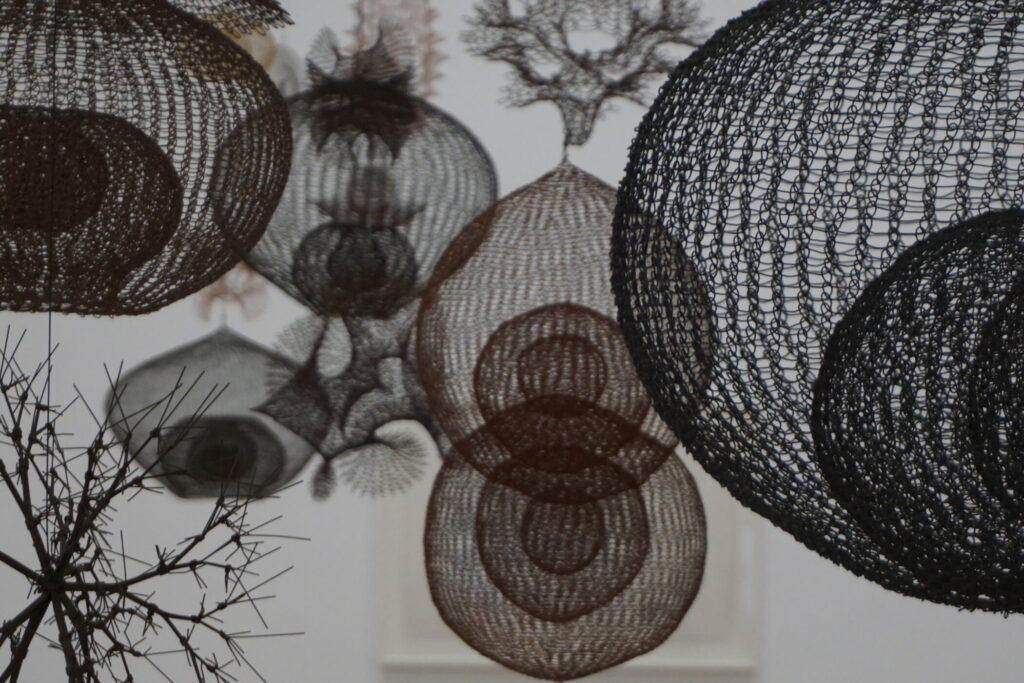
The wire works made by Asawa caught me for their unique properties of the material. By working with wire loops, I can interlock, expand and contract a wireline during the making process, which can also be described as drawing in the air. I looked at a recent exhibition of her work by Whitney: Ruth Asawa Through Line (Sept 16, 2023, to January 15, 2024) Asawa was a firm believer that everything is connected. The transparency effects in Asawa’s sculptures are most apparent when hung in groups. This was her preferred method for her sculptures to be displayed both in exhibitions and at her home, where she would suspend vast assemblies of sculptures from her ceiling. I have played with these ideas in my studio and at home and feel comfortable using them during the exhibition. Grouping the works as sculptures shifts from individual units to larger cohesive installations. The boundaries between each object blur due to their material transparency, creating a roomy and architectonic spatial effect.
On the Courtauld website, I read a reference by Ann Reynolds, who apparently, in her essay ‘Lessons in Transparency’, argues that when hung in groups, Asawa’s sculptures evoke both ‘literal’ and ‘phenomenological’.
I recently learnt that she often created smaller interior forms using the narrowest gauge of wire in her multi-lobed sculptures. She would then develop using progressively thicker gauges to form the outer layers. I did not use this technique, and in hindsight, I understand why her method would work much more straightforward. Asawa’s structure concealed the breaks and joins between her different wire strands. The effect of using multiple wire strands to create a unified surface gives her sculptures the structure and appearance of total continuity: Asawa’s sculptures float weightlessly. Her sense of insubstantiality is enforced by her use of loops incorporating space into the form of the sculpture itself. B
I see a connection between the act of mothering and the act of making. In Jordan Troeller’s analysis of Ruth Asawa’s work, she suggests that Asawa’s identity as a mother was central to her artistic practice, blurring the boundaries between labour in the home and labour in the studio.
My art holds traces of my own experience as a mother. The physicality and time-consuming process of bending and shaping wire symbolise the unseen labour of care, much like Asawa’s looping technique reflects the intertwining nature of life’s tasks. In embracing these materials and techniques, I channel the nurturing instincts of motherhood while also exploring the fragile balance between freedom and containment, protection and isolation. This duality reflects both the emotional complexity of caregiving and the creative tension within art-making.” The repetitive, meditative weaving of wire mimics the nurturing and care inherent in motherhood. Just as mothers construct safe spaces for their children, I construct nests reflecting care, protection, and loss. My hands and fingers sometimes ache after working with the wire. I have accidentally pieced wire into my flesh whilst working, and the blood stains of these cuts on work come to mind. I took images of it as I was attending to my wound and having to clean the work I was doing. I have since learned to work with tape/plaster to protect my fingers.
As I worked on the 21 sculptures which became part of a group hanging, I became fascinated by how Asawa’s pieces embody materiality and dematerialisation. Her ability to suspend forms within forms challenges our sense of gravity and movement, which I sought to explore in my work. By incorporating these ideas, I aim to create pieces that engage viewers in a similar experience, where solidity and transparency blend, and what’s inside is revealed on the outside.
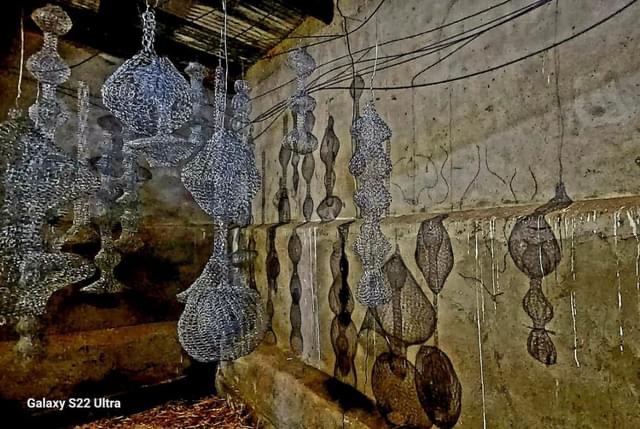
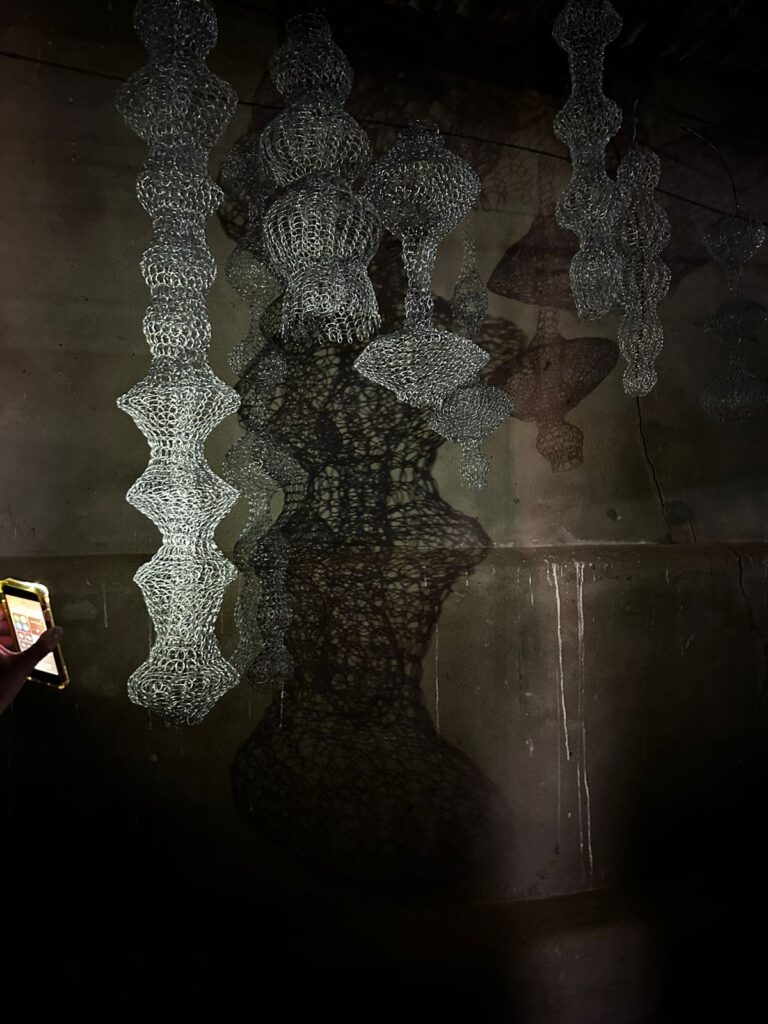
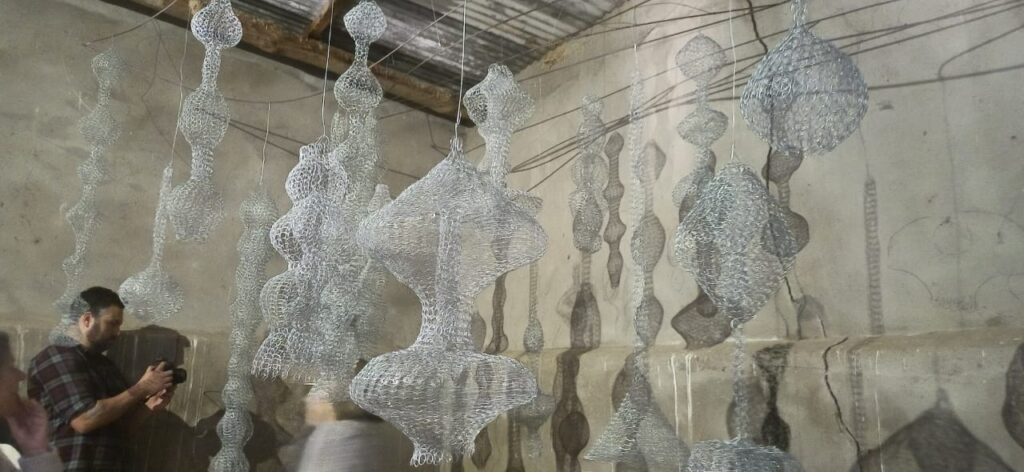
I’ve shifted the traditional structure of a nest by placing what would typically be the inner chamber—designed for shelter and protection—on the outside. This reversal challenges the expected order and creates a dialogue between transparency and solidity. Viewers are invited to look through the nest’s layers of wire, which seem to extend infinitely. For me, the boundaries between inside and outside dissolve, reflecting how my process of making is a continuous development of form. Like the sociable weaver nest, the outside cannot exist without the inside—inseparable.”
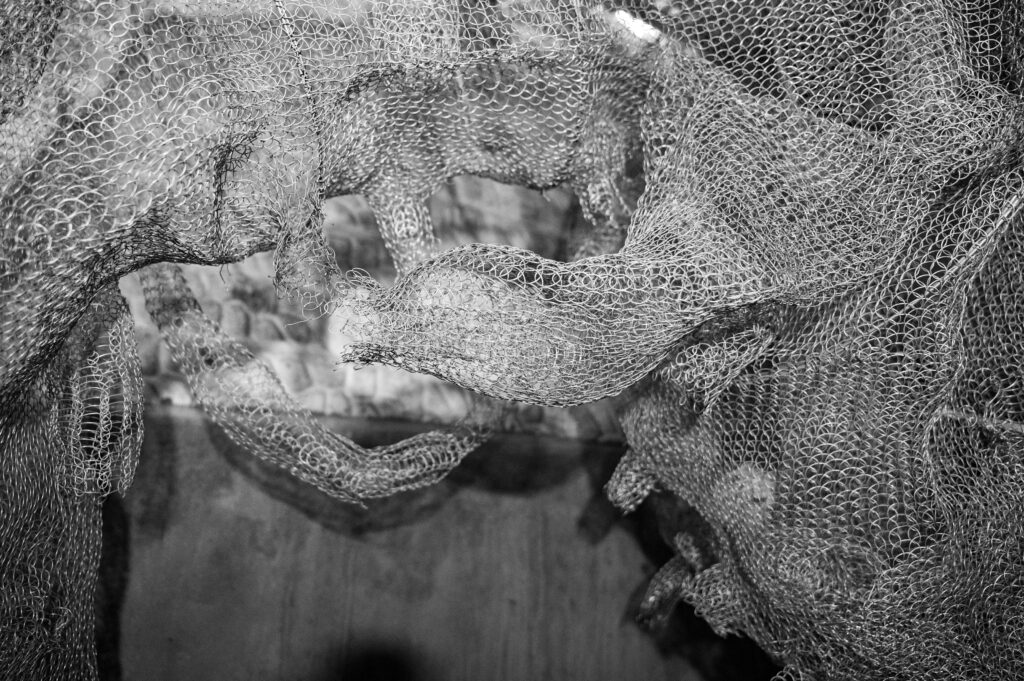
Prof R Tompson shared access to many documents of the Fitzpatrick Institute as well as other publications. (Cost and benefits in extreme nesting associations: do Sociable Weavers benefit from hosting African Pygmy Falcons? October 2023 online library wiley-com.). The research I was exposed to during this project made me more aware of how adaptability to a changing environment is a critical component of survival and resilience.
I added another grouping of smaller ‘nests’ together and placed more significant round objects floating on the dam.
It is essential to consider how my work has travelled—where it started and where it is now. I recently wrote a blog, Why a Nest? I am still contemplating what these nests are and how I almost ‘lost’ myself in them as a way to deal with my thoughts and life experiences.
The images below are as actual as I can get to my explorative journey. It started with drawing with charcoal and then an even more enormous mural to get the feeling of size and textures. I then moved on to make a nest with raffia and plant materials. I share them all in monochrome as this is how I feel the wire as material contributed to my ideas about transparency and light in the work.
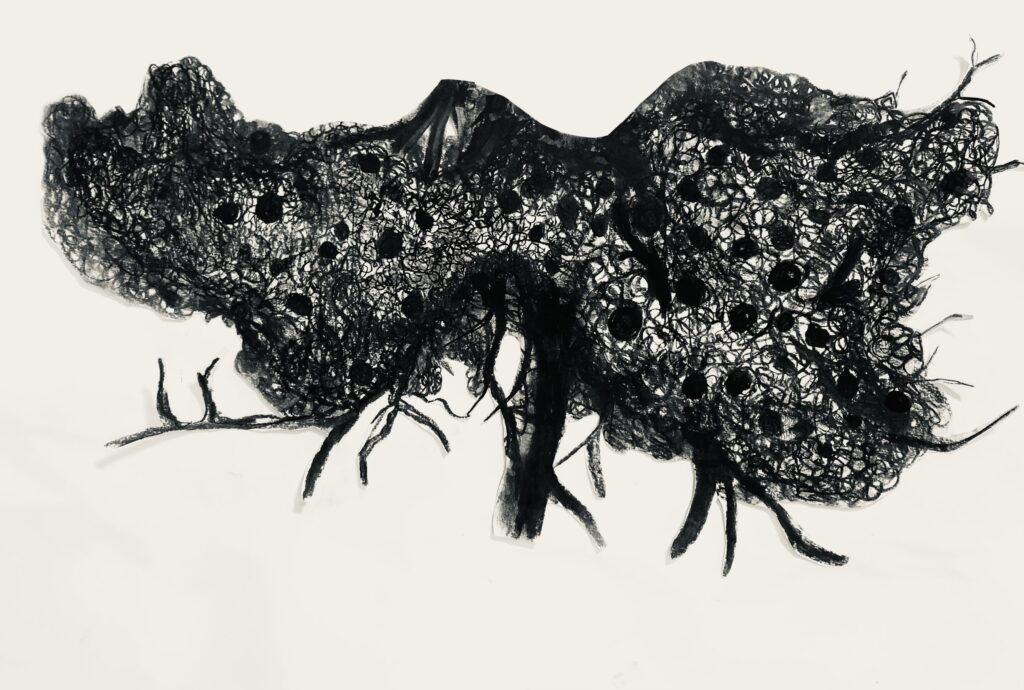
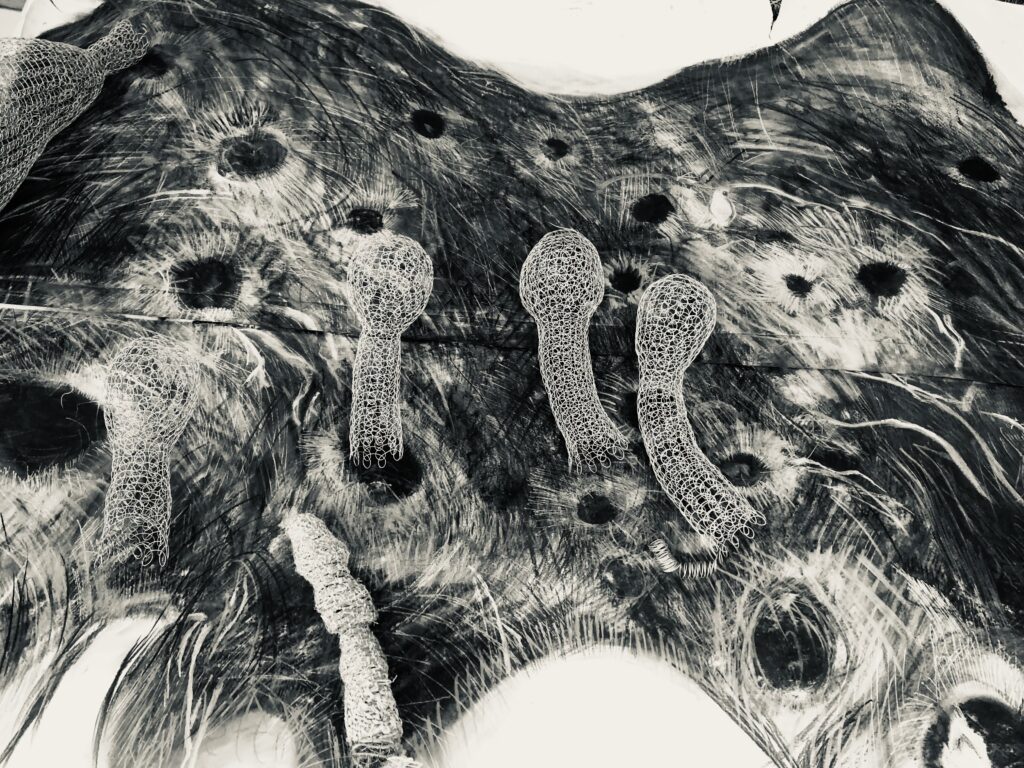
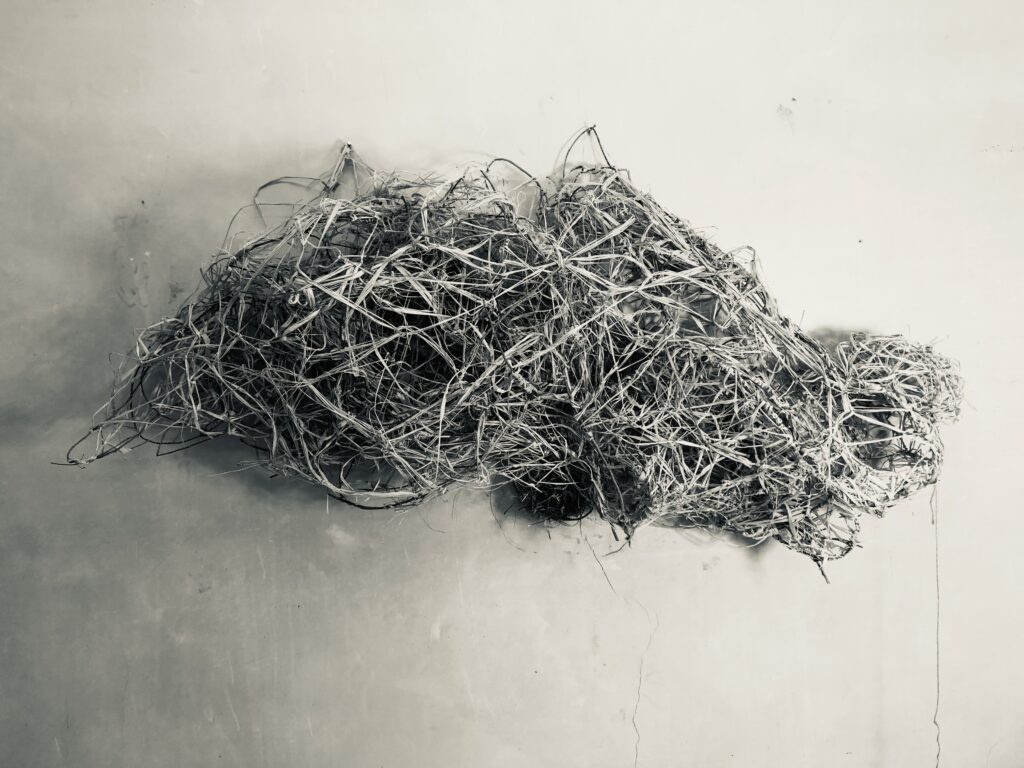

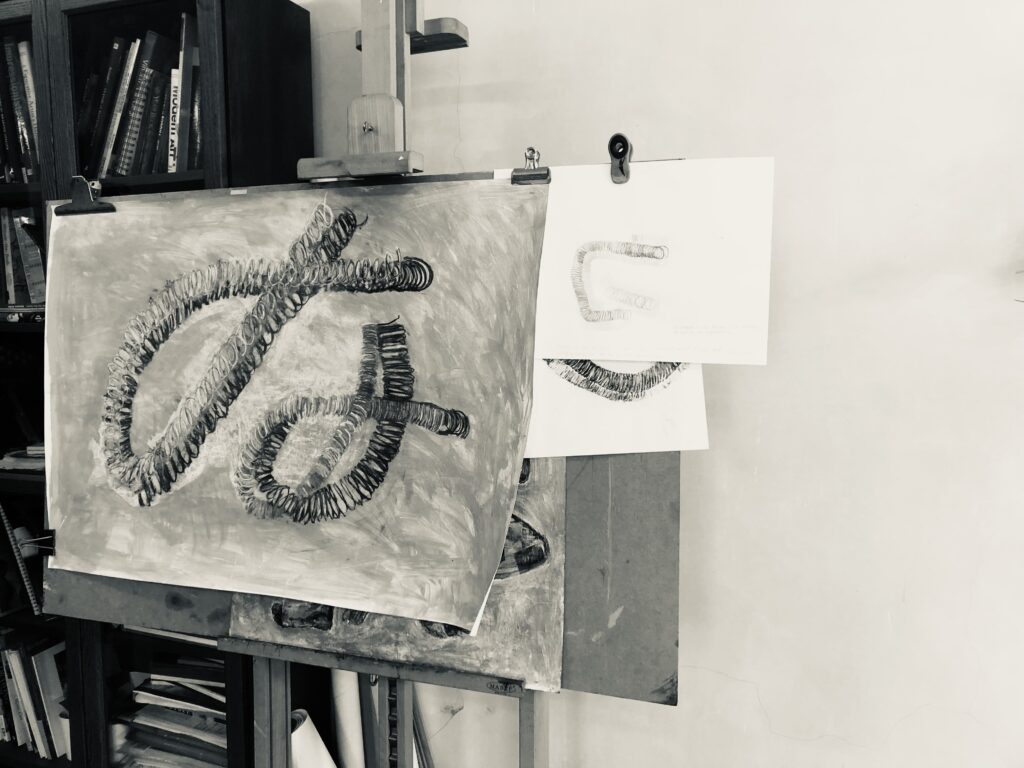
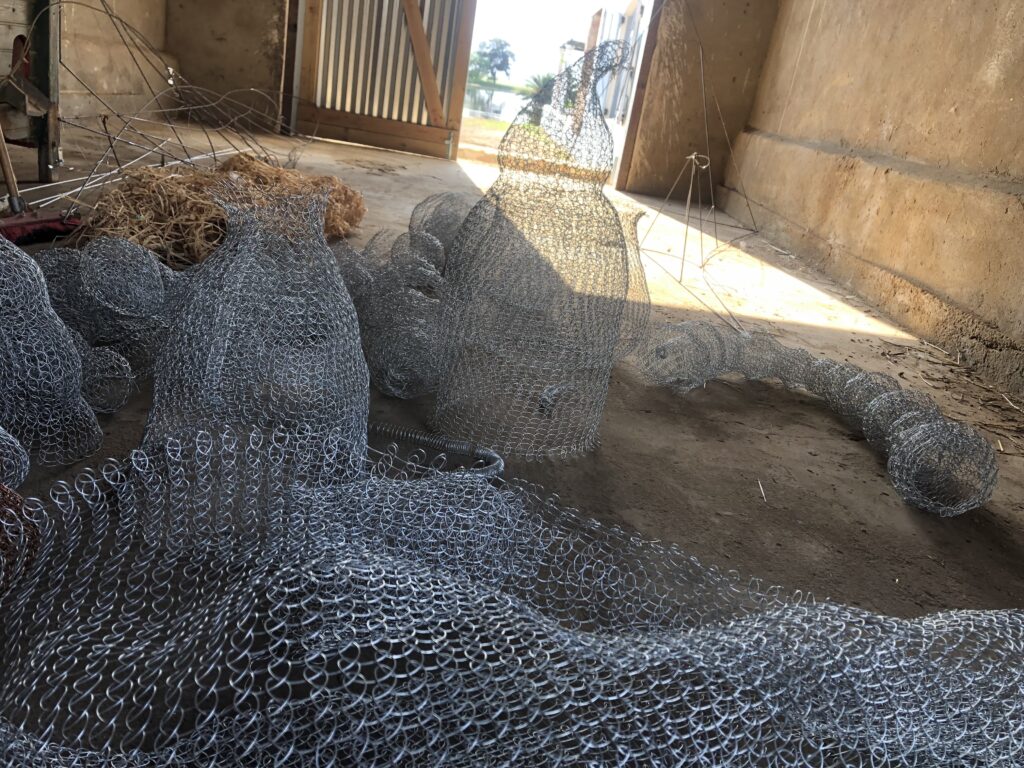
I am reminded of a tutorial during my previous course with tutor Michele Whiting: We talked about how nests are made and the materials used, and then we considered the space that happens when humans and non-humans collide. Nests aren’t always made out of natural substances (September 2023), and birds introduce human materials (M Whiting shared that she saw house martins using human hair). This collision is essential to my thinking and even the idea of human scale.
Another point worth contemplating is how the nest functions as a hybrid space.
By using wire—a material often associated with fences, cages, and control—did I challenge traditional notions of a “nest”? Do I invite viewers to question how we impose our constructs onto the natural world? Is the nest a place of care, or does it impose boundaries that echo human tendencies toward control and restriction?
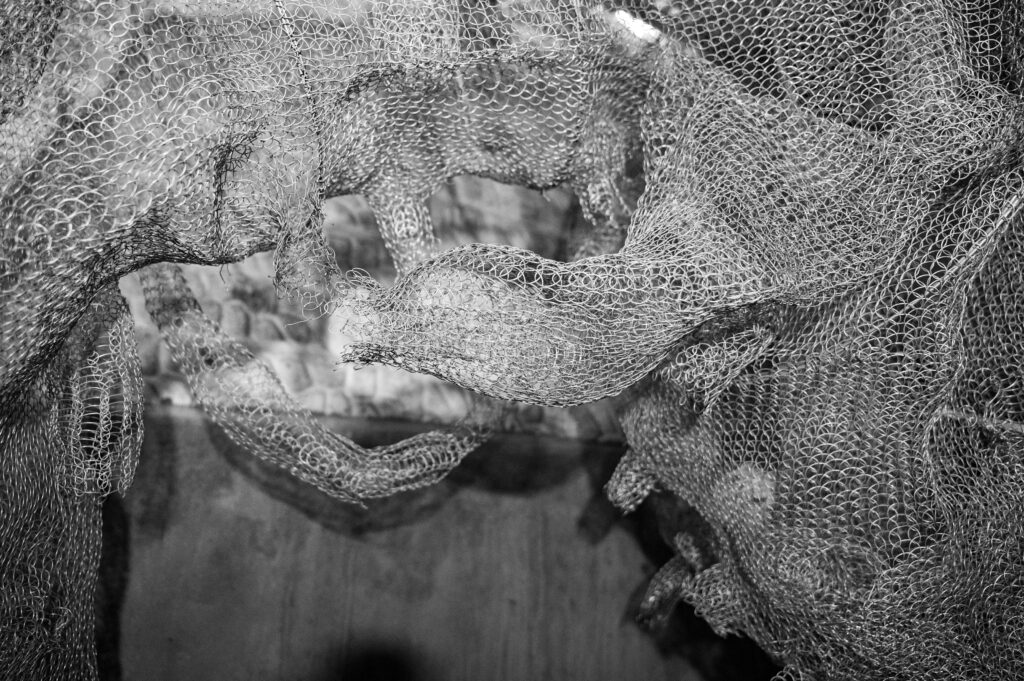
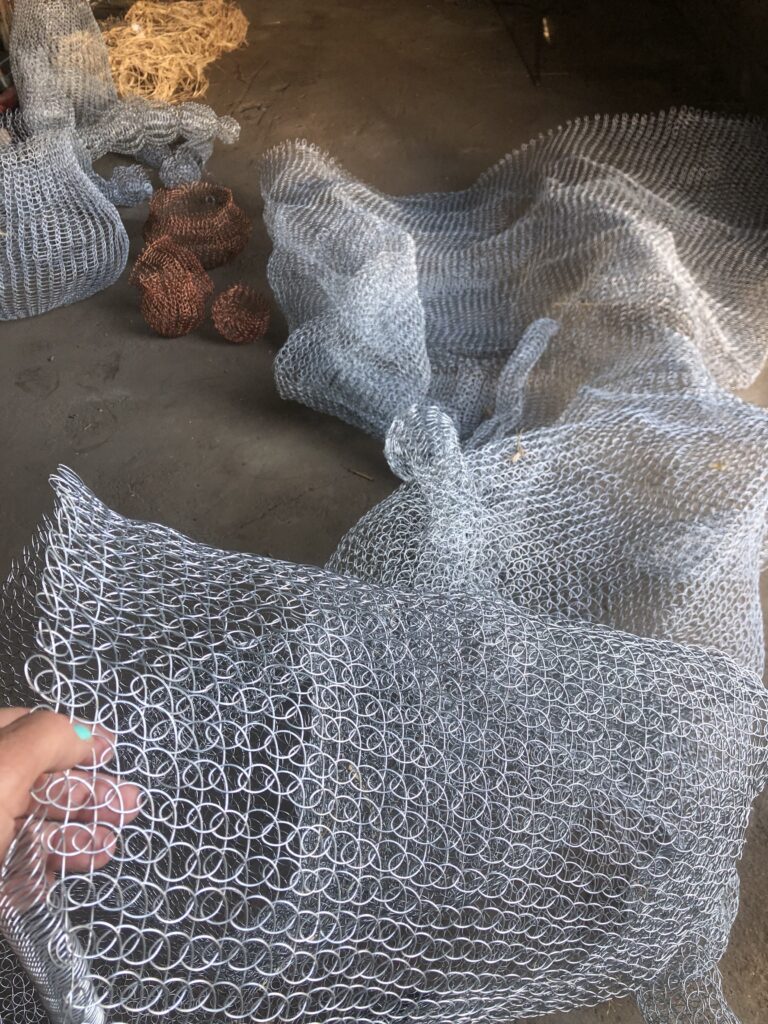
This collision becomes part of the space’s otherness. The nests are not natural or artificial but occupy a middle ground. This reflects broader questions about how humans relate to the natural world—whether we are participants or distanced observers imposing our structures upon it. Using human materials in nests symbolises how human culture encroaches on or mingles with natural spaces, transforming both in the process. One of the most exciting materials I read in my research, which birds use in their nest-making, was the anti-bird spikes. (https://www.hetnatuurhistorisch.nl/fileadmin/user_upload/documents-nmr/Publicaties/Deinsea/Deinsea_21/Deinsea_21_17_25_2023_Hiemstra_et_al.pdf) The authors refer to the Anthropocene effects, and because living biomass is outweighed by anthropogenic mass, alternative nesting materials are increasingly being adopted by urban birds. I found it excellent to understand that the rows of upward-pointing anti-bird spikes became an appropriate substrate for a nest, as the pins help to secure the twigs and support the structure, especially on sloping surfaces. This reminded me of putting my hand into a sociable weaver nest that has fallen onto the ground (branch broke) and feeling the grass at the nest’s entrance (tunnel). It was very spiky. Thinking that these birds do not weave, they place the grass blades into the structure in a way a thatch roof is made.
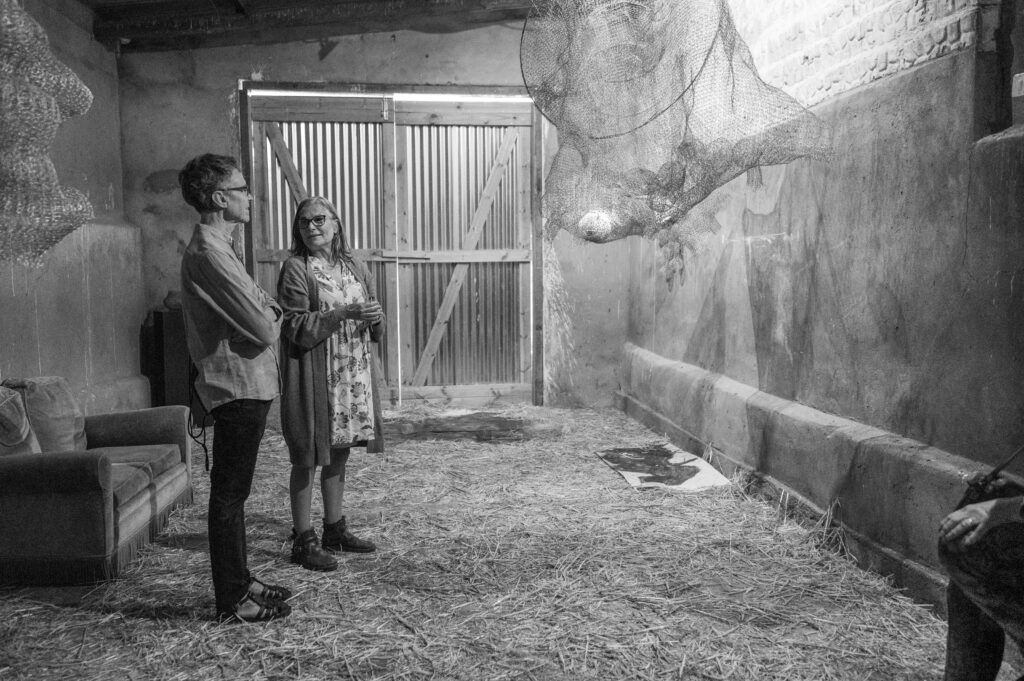
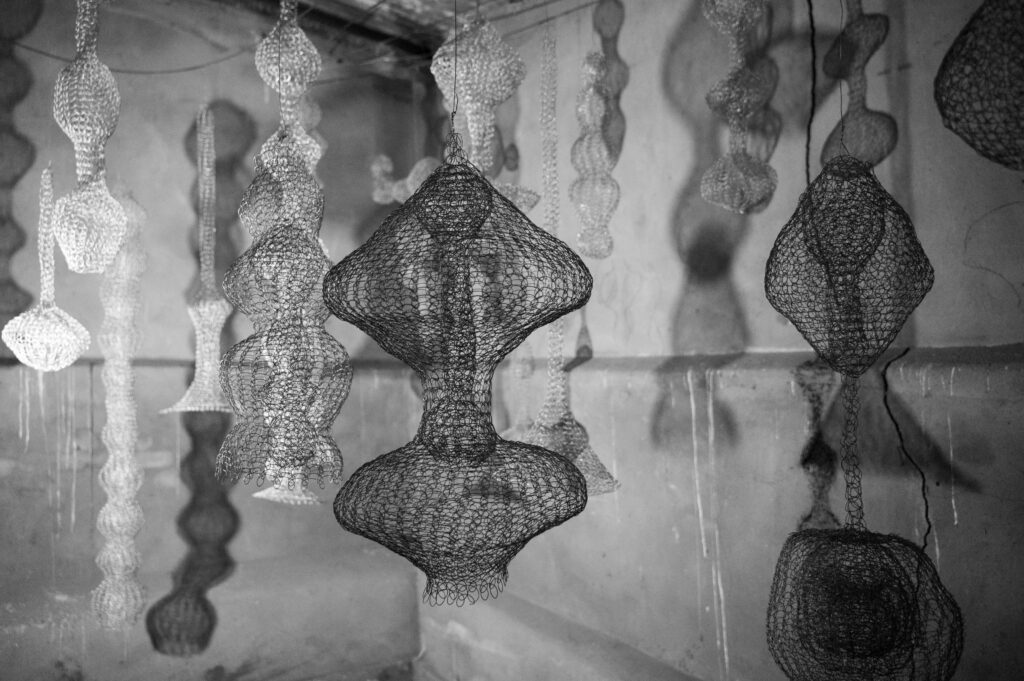
Exercise 6: SYP, FIne Art and OCA peers
One of the questions which came up was, WHY A NEST? In reaction, I wrote a short blog post after this discussion. (https://karenstanderart.co.za/why-a-nest/. This is a personal place of reflection, and more ideas flowed from this:
- It was work I needed to do for myself. (“I am happy to see you ‘own’ your art, and own your story”)
- It was seen as soulful and powerful
- Consider viewer interaction
- Consider a pre-recorded video performance
In my making, I started to explore the idea of a nest within a nest—layering the work. I looked at a work by Asawa, where she worked with copper wire—it seems there are four layers within the work, a form within a form.
I shared my ideas about writing about the wire nest with my peers in the OCA EU group and other local friends/artists. Some wrote feedback on my blog, and I had telephonic and WA discussions with others. My attempts to write accessible and use ‘non-abstract’ language were welcomed and were seen as a way of making people feel welcome to access my personal space. My reflections were seen as attractive regarding how the time of the making process was used to weave in a personal story. (https://karenstanderart.co.za/hotelkalahari-2024/). I am also thinking about how thought in one’s making process can also seen as a function of time (Bill Viola sees making and thinking about making
Viewer interaction: One suggestion was to ask viewers whether they could connect their personal story to the work and if they would share it. One could offer viewers a pen and paper to write their personal story and attach it to the nest. I like this interactive approach.
Personal performance: The suggestion was to write a personal letter to my son, crumple it, burn it, and film the process. The video could run in the exhibition area. As part of a performance, I could get into the nest and do the writing there. I was not comfortable sharing this work during the exhibition. I felt it was too personal and decided to add it only to the blog.
I have been part of the OCA EU group for at least the last six years, and for the previous two years, I have been part of the Core Group planning and marketing the group sessions and actions. In this group, I became part of a smaller support group on WhatsApp. We discuss and share work and ideas. My most extensive learning came from this mixed group of students in different cohorts, like textile, creative art, and painting pathways. By sharing work, there is a wide range of input and ideas. I explored more materials and learned from the others. They have been great critiques of my work and influenced not only my making but also my thinking.
One of the students I have collaborated with, Annette Holtkamp, decided to collaborate again. The idea is to use the steel wing I made, put up more minor works I made with raffia and plant materials, and add her works as a QR code. I will have small photos of the pieces above the barcode so viewers can know what they will see. An iPad will be on hand to scan the QR codes – I want the viewer experience to be easy and comfortable. This work is envisaged to be outside – the wing will be installed against an outside wall of a barn. Due to a lack of Wi-Fi reception, I could not share this work as envisioned.
RESEARCH TASK: PLATFORMS FOR ARTISTIC DISSEMINATION
I will survey the field and hone in on my chosen area.
Artist Websites
I have been using WordPress for my websites and have focused primarily on my studies as a blog for practice and theoretical work during the course. I registered a .com and .co.za domain and will consider using them more for my work and promotional purposes. Up to now, I have seen my interactions on social media, (I am using Instagram) more as the place where I start building up a relationship outside of my studio.
For the major project and my exhibition, I added a menu to my current site where all the work for the final part of my studies is situated. This site will be available for viewing and sharing in all my communication about the exhibition. The site’s name is Kalahari Hotel, and in the weeks before the exhibition, as I prepared the marketing material, I started adding posts here, such as my artist statement for the exhibition, a press release, etc.
My website’s homepage was changed to focus on the upcoming exhibition, and I plan to change some of the images on this page weekly. (There are three smaller images on the page, and I will change these weekly.) I tried a layered effect by placing the writing on top of an image, but it was difficult to read. See the image below.
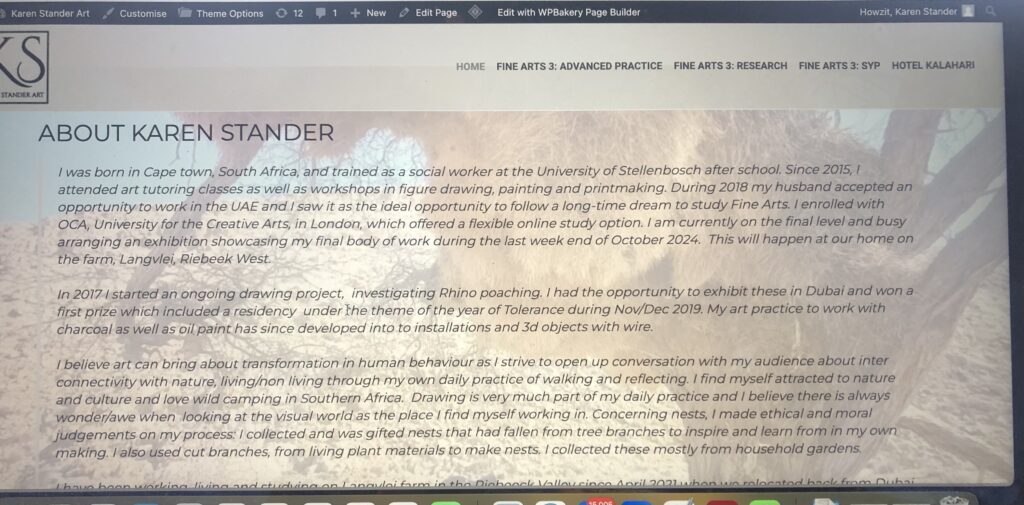
I received valuable feedback from my OCA EU student crit group. We discussed the importance of images for viewers during a visit to a website and making the reading shorter. We consider that people move fast when viewing a website. I never considered how this site is presented on a cellular phone. This was a primary motivator for making more changes. The home page is now divided between an image of me viewing a nest and my introduction. I shortened the ‘about me’ part. I am comfortable with the viewer experience on the cellular phone log-in, which is also visually pleasing.
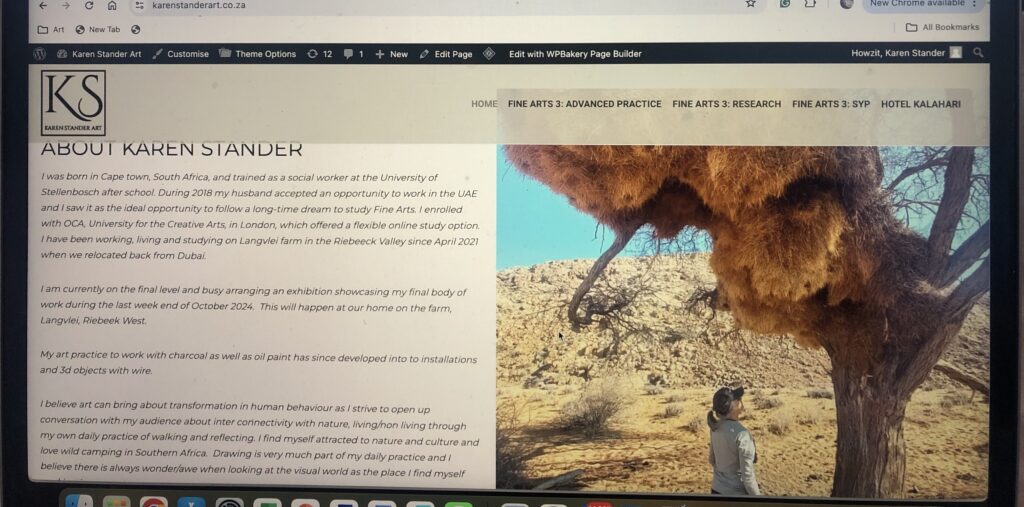
Traditional Media and Press Releases
A press release should address the following points:
- Briefly and in simple terms, what is the work about? Why is it exciting and worth reading about?
- Who has made it? What is their background? Why have they done the work? Who else is involved in the project?
- When and where can the work be seen/heard/experienced? (physically and online)
- Where will the artist be available for interview or comment?
Press Release
For Immediate Release
“Kalahari Hotel 2024” — An Exhibition by Karen Stander
Dates: 25 October 2024 to 29 October 2024
Opening Reception: 25 October 2024 at 18:30
Venue: Langvlei Farm. Station Road, Riebeek West.
Experience a Unique Artistic Journey Inspired by Sociable Weaver Birds
Kalahari Hotel 2024 is a deeply personal and evocative exhibition by artist Karen Stander. At the heart of this work are the intricate wire nests inspired by the communal structures of sociable weaver birds, known for building vast, multi-chambered nests in the Kalahari Desert. These nests symbolise home, community, and the delicate balance between protection and confinement.
Stander has created sculptures through the wire, inviting viewers to explore themes of care, loss, and reconnecting with nature. Drawing on personal experiences, particularly the loss of a child, the work embodies the tension between nurturing and letting go, both in human and natural relationships.
The exhibition opens with an address by [Ornithology Professor’s Name], who will share insights into the nests of sociable weavers. This talk will bridge the gap between the natural world and the artist’s reflection on care and protection, providing a scientific and philosophical context to the work and offering viewers a rich, multi-layered experience.
Why It’s Worth Experiencing
“Kalahari Hotel 2024” uniquely combines art, nature, and personal storytelling. The wire nests, with their transparent layers and intricate design, create an otherworldly environment that invites contemplation on the human need for safety and the complex relationships between species. The exhibition presents both a personal narrative and a broader reflection on interconnectedness in life, making it a compelling experience for art lovers, nature enthusiasts, and those seeking a meaningful exploration of care and community.
About the Artist
Karen Stander is a fine artist based in the Riebeek Valley. She focuses on sculpture, drawing, and installation art. Her work often explores themes of home, care, and the tension between security and isolation. This exhibition, part of her major project for her BA Honours in Fine Arts, reflects on Stander’s ongoing research into the communal nests of sociable weavers, drawing parallels between natural structures and human emotional landscapes.
Where & When
The exhibition runs from 25 October 2024 to 29 October 2024 at Langvlei Farm, Riebeek West. Visitors can experience a walkabout with the artist on the opening day and enjoy snacks and drinks as part of the reception. Images, a video, and insights from the exhibition will be available online for those unable to attend in person.
Interview Opportunities
Karen Stander will be available for interviews on [mention any specific days or offer availability upon request]. Media inquiries can be directed to info@karenstanderart.com.
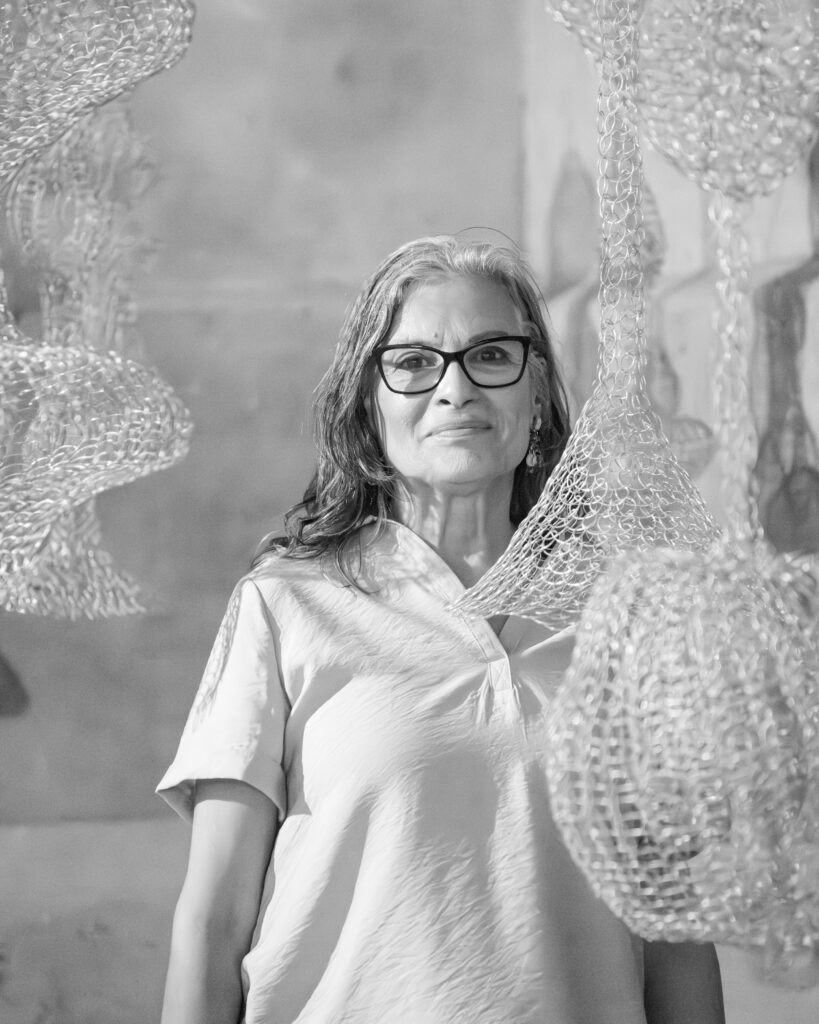
Considering the viewer experience as part of my exhibition strategy
I think most learning came from where I had to look at exploring the conceptual and physical impact of light and shadow in my work. It was important how viewers engage with the installation. I felt strong on emphasizing spatial and sensory interactions. I attempted to use lighting strategies in the exhibition to cast shadows, making the wire nests feel ethereal or transient. I have many images showing light falling across the wire objects and can imagine that writing notes on how shadows amplify the experience of fragility, resilience, and ambiguity can add to this reflection.
Can this visual experience be in the form of photo images and or video material?
Experiment with an ARTIST BOOK or WRITING (as a Practice) about this project
I enjoy the idea of writing as part of my artistic practice and have enjoyed writing my blog and social media posts, which focus not only on promotional purposes but also on the work and process itself.
I listened to a video recording in which Gilda Williams discusses the benefits of writing as an artist. (https://www.youtube.com/watch?v=Oqi_k1RQsnQ&app=desktop) Thinking of the book, the one thing that motivated me was that the writer did not discriminate between different types of writing—making one more important than the other. She did, however, place a strong emphasis on where the idea came from. I am glad I was asked why and how by my peers. I realise this is where one can write authentically.
An interesting idea was to think about ‘ready-made text’—she shared the concept of poet Kenneth Cole, namely to look at one’s internet browser. It is a visual stream of one’s consciousness—for Cole, this is a portraiture of oneself. I took a photo of my screen, and clearly, there are so many open browsers I have been using/looking at for my blog writing. Williams is not a fan of using ‘ready-made’—she feels something should happen after the research, during the writing about it. I agree that using the info from my open screen adds contextual information and can encourage viewers to see the connection between digital research and physical creation, enhancing the narrative around my wire nest installation and inviting viewers to engage with the ideas supporting the work. My idea was to compile a book after the physical encounter with visitors and my work. I can use photo images of the work and write about visitors interacting with it. As I placed a couch in the space I invited visitors to sit there, and during the course of the opening evening and other visits, viewers did use that invite to sit. Some enjoyed the space for its dimmed light, shadow play, sounds and general natural feel.
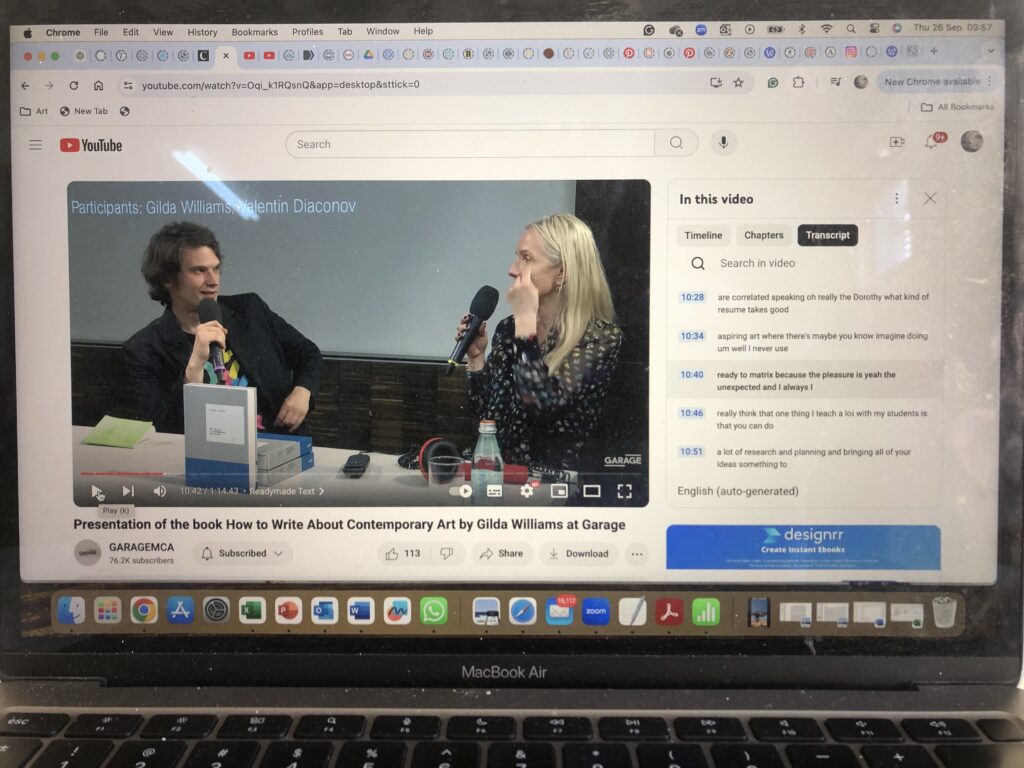
To translate my browser history snapshots into a compelling book, I consider breaking them down into thematic chapters or “windows,” each focusing on a specific theme related to my research and creative journey. I can organise the snapshots by themes or concepts, like connection and fragmentation, nesting and belonging, memory and place – or I could use reflections or annotations about each browser snapshot – why I visited the site/article, how it ties back to my creative process or broader questions, I explored. I also considered my ‘fieldwork’ – visits to the nests in nature. As a final reflective note, I would like my writing to summarise how my journey with these nests—through field visits, sculptural process, and intellectual exploration—has deepened my understanding of connection, care, and the resilience found in both nature and art.
I have the following concepts to consider:
Part One: Roots and Beginnings Discuss context and field observations by sharing information about the nests, the birds and describing my own visits to these nests (share notes/images/skecthes with annotations. I can incorporate sensory and spatial details to capture the physical experience of these spaces, using field notes and reflections to create an immersive atmosphere. Include scientific and ecological details about the sociable weaver nests and their environment, emphasizing themes of resilience and interdependence. (The information shared by prof Thomson could be discussed.)
Part Two: Weaving and Wires – The Artistic Process and Materiality
Here I transition to the studio, where I transformed natural observations into physical forms through wire sculptures. This section could delve into my techniques, challenges, and discoveries in working with wire, light, and shadow.
Content Ideas can be around sharing the detail of my process of creating wire nests as an echo of the weavers’ methods. Highlight the techniques, such as layering wire and manipulating light, that parallel the structures of natural nests. I can add illustrative photos of in-progress work or close-ups of wire pieces, with notes explaining how the wire’s interplay with light and shadow brings new meaning to the forms. There is also the option to discuss the concept of materiality and why wire is significant—its strength, flexibility, and transparency in holding both light and shadow, capturing the essence of the nests and evoking layered meanings.
Part Three: Shadows and Light – The Viewer’s Experience
I will place focus to explore the conceptual and physical impact of light and shadow in my work. This section could provide insights into how viewers engage with the sculptures, emphasizing the importance of spatial and sensory interactions.
In terms of content I can discuss how I used lighting strategies in the exhibition to cast shadows, making the wire nests feel ethereal or transient. I can also share images or sketches showing light falling across the wire objects, with notes on how shadows amplify the experience of fragility, resilience, and ambiguity.
Relate this to ideas from Bill Viola and other artists working with light as a medium, using it to evoke experiences that shift as viewers move through the space.
Part Four: Displacement and Belonging – Heterotopias in Nature and Art
Focus: Connect the nest sites, work, and broader themes of place, belonging, and displacement, using heterotopias as a lens to consider how spaces are imbued with personal and communal meanings.
Content Ideas:
Reflect on how sociable weaver nests serve as heterotopic spaces—simultaneously natural and social, anchored and fluid. This parallel with human experiences of belonging could explore how shared spaces act as havens or hold constraints.
Address themes of displacement and choice, highlighting how both people and birds adapt to shifting environments, yet rely on communal bonds and support networks.
Tie in virtual spaces vs. real spaces, mirroring the way natural and constructed nests are both “here and elsewhere.” Consider how the digital world impacts our sense of belonging and the simplicity of being present, juxtaposing this with the nests’ physical resilience.
Part Five: Reflections – ‘Ready-Made Text’ and Annotated Stream of Consciousness
This could act as a portrait of my mental journey, adding a self-reflective layer to the work. I can create a series of annotated screenshots of my internet browser history that highlight research sources, articles, and images that informed my ideas. I can write a brief commentary or annotations on each screenshot, explaining how the source inspired or shaped aspects of my work. These snapshots add an intimate, contemporary layer to the book, connecting my ideas to a wider conversation.